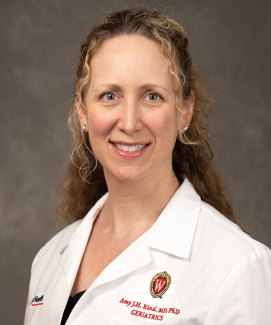
People in the most disadvantaged neighborhoods in the United States may face greater odds of developing Alzheimer’s disease-related brain changes, according to researchers at the University of Wisconsin School of Medicine and Public Health.
Using a technique they developed that links neighborhood socioeconomic information with brain bank samples, researchers found an association between neighborhood disadvantage and the presence of Alzheimer’s disease-related brain changes shown during an autopsy. Study data showed that people who lived in the most disadvantaged neighborhoods have roughly twice the odds of having these brain changes than people who lived in the wealthiest neighborhoods.
Neighborhood disadvantage, a fundamental social determinant of health, directly reflects the income, employment, education and housing quality in a precise geographic area, according to Amy Kind, MD, PhD, associate professor of medicine (geriatrics) at the UW School of Medicine and Public Health, who led the study along with Ryan Powell, PhD, MA, assistant scientist in the UW Department of Medicine Health Services and Care Research Program.
“However, this is the first study of its kind to link neighborhood disadvantage to the brain tissue markers related to Alzheimer's disease,” Kind said. “Our work provides a new way to link social determinants to biobanks, and neurons to neighborhoods. It is very exciting and opens opportunities for countless other studies which may further examine the interplay between social factors and fundamental biology, providing opportunities for new therapies and interventions.”
The study “Association of Neighborhood-Level Disadvantage with Alzheimer Disease Neuropathology” was published in JAMA Network Open on June 11, 2020.
For the purpose of this study, researchers defined the neighborhood disadvantage using data provided through the Neighborhood Atlas, a free, online tool Kind and her team developed in 2018.
Alzheimer’s disease is a progressive brain disease that causes declines in memory and thinking skills. Research in the last decade has shown that Alzheimer’s disease-related brain changes, including a buildup of abnormal levels of amyloid proteins, can begin more than a decade before a person experiences the symptoms of Alzheimer’s disease. Researchers can detect evidence of these early brain changes with advanced brain imaging scans, but a brain autopsy upon death is the most conclusive way to confirm Alzheimer’s disease. For this reason, Alzheimer’s Disease Research Centers have brain donor programs that allow Alzheimer’s disease research participants to donate their brains after death. Brain donation helps scientists better understand Alzheimer’s disease and related dementias.
Study design
Powell and Kind’s study included data from people who volunteered to donate their brains for research at one of two Alzheimer’s Disease Research Center-affiliated brain banks – the Wisconsin Brain Donor Program or the University of California-San Diego Brain Bank. The brain donors passed away between the years 1990 to 2016, and, as typical for most tissue banks, no information was collected on social factors of the donors. Doctors examined donated brain tissue samples for the presence of two kinds of Alzheimer’s disease-related amyloid deposits.
“Our neuropathology team determined the presence of Alzheimer’s disease-related brain changes using extremely sensitive measures,” Kind said.
The study team then linked the autopsy findings to detailed neighborhood conditions based on the last known residence before death for each of the 447 brain donors in the study. Donors from disadvantaged neighborhoods were less common than their counterparts from wealthier neighborhoods.
The analysis found that increasing neighborhood disadvantage is associated with increased odds of the presence of Alzheimer’s disease-related brain changes in autopsy results. However, the authors agree that more research is needed to confirm these findings.
Future implications
The team also examined this data from another perspective – analyzing how difficult it might be for people from disadvantaged neighborhoods to access Alzheimer’s Disease Research Center brain bank services. Using advanced geographic simulation techniques, the team determined that only 56% of the U.S. population lives within 100 miles of a National Institute on Aging-affiliated Alzheimer’s Disease Research Center, and that those within reach are more often from the wealthiest neighborhoods.
This simulation suggests that geographic access is likely more difficult for almost half of the country, and particularly challenging for those living in more disadvantaged neighborhoods – a population that scientists need participation from to get a more well-rounded view of the disease, according to Powell.
“Diverse representation is a known challenge and there is a lot of work going on in the field to improve participation,” Powell said. “But with future advancements in treatment and prevention tied to existing data and research, we need to continue to make diverse participation and geographic access to research center services a priority in ongoing strategy.”
These research findings have the potential to help researchers develop precision medicine strategies that help doctors identify individuals at increased risk for Alzheimer’s disease and provide tailored treatment and prevention efforts to improve health.
“As the field moves forward, it is important to remember that the evidence needed to fulfill the promise of precision medicine in Alzheimer's disease is only realized by growing biobanks with diverse representation,” Powell said.
Alzheimer’s disease researchers at the University of Wisconsin–Madison focus on improving early detection of Alzheimer’s disease, identifying risk and protective factors, and finding ways to delay onset and progression.
Kind’s co-authors on this study include Powell; William R. Buckingham, PhD; Jamie L. Larson, PhD; Leigha Vilen, BS; Menggang Yu, PhD; M. Shahriar Salamat, MD, PhD; Barbara B. Bendlin, PhD; and Robert A. Rissman, PhD.
- Log in to post comments



